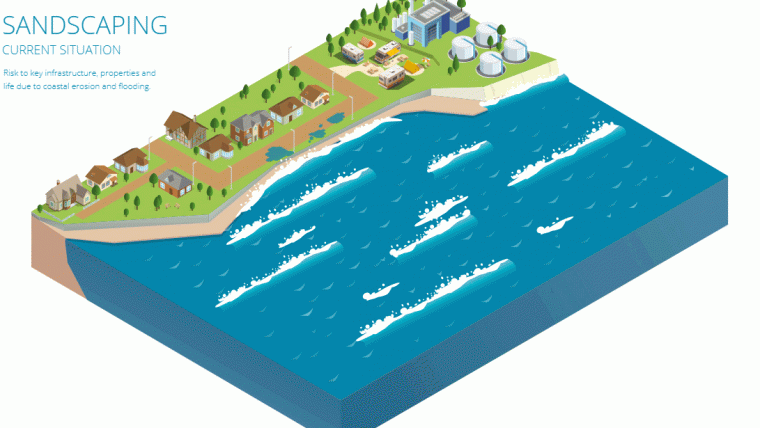Building with Nature along the UK Coast
The UK's Bacton Gas Terminal and residents of surrounding Norfolk villages will benefit from Dutch experience as Royal HaskoningDHV completes the detailed design for a coastal protection project. This is the first time that sandscaping will be used in the UK to provide a sustainable long-term solution. This follows the earlier example of the ‘Sand Engine’ that has already been applied in The Netherlands.
In this scheme 1.5 million cubic metres of sand will be placed along the coast to protect a 5km stretch of the UK’s east coast including the nationally critical Bacton Gas Terminal (operated by Shell and Perenco) together with its neighbouring communities.
Long-term coastal erosion is depleting the area’s beaches, leaving cliffs and seawalls exposed. Severe storms in 2007 and 2013 caused significant cliff erosion and flooding, underlining the project's urgency.
The project is a public-private venture of Bacton Gas Terminal together with North Norfolk District Council (NNDC), where NNDC is the Operator.
Green Infrastructure
Gökhan Doygun - commercial advisor at Shell responsible for collaboration between the Bacton Terminal Operators, Royal HaskoningDHV and other parties – commented that the Bacton Gas Terminal is providing about a third of the UK's gas supply. To protect the Terminal and the associated pipelines, we need a solution which will be sustainable and will allow us to continue operating into the future. Due to its green nature, Sandscaping creates a great opportunity for the Bacton Terminal and the neighbouring villages to collaborate. He understands the sandscaping solution does more than just protecting the Bacton Terminal as it creates real benefits for our neighbouring communities because the sediment will improve the beaches nearby. It is also a sustainable solution as it can be re-nourished and maintained.
Sandscaping
Jaap Flikweert, Flood Resilience Leading Professional at Royal HaskoningDHV added that in the Sandscaping initiative they are working with British partners to translate the Dutch Sand Engine (Zandmotor) to the very different context of the UK. It is all about using the natural energy of the sea to distribute the sand and this can make sandy solutions affordable. It enhances the natural coastline without leaving a permanent mark and can be adapted and extended easily if needed in the future. Sandscaping also means design for multiple functions and stakeholders, to generate benefits and funding.
The volume of sand to be used at Bacton is approximately equal to 200 football pitches covered 1 metre deep in sand, and will come from existing licensed dredging areas.
Public consultation has begun and Royal HaskoningDHV’s work on the Environmental Impact Assessment (EIA) is underway. The company will also prepare the business case to secure national Government funding, as well as developing the operations, maintenance and monitoring plan for the scheme with placement due to take place during summer 2018.
The first Sand Engine was introduced in 2011 on the Dutch coast and offers an effective soft coastal management solution making use of natural processes. The method entails depositing a large volume of sand in a location from which it is distributed by coastal processes over a larger part of the coast.
Royal HaskoningDHV was heavily involved in the design of the original Dutch concept, as well as delivering the Environmental Impact Assessment (EIA). The Bacton project is the first time the concept will be applied outside the Netherlands.














